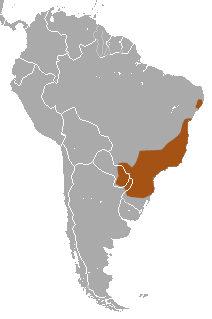Grossohropossum
| Grossohropossum | ||||||||||||
|---|---|---|---|---|---|---|---|---|---|---|---|---|

Great ohropossum ( Didelphis aurita ) |
||||||||||||
| Systematics | ||||||||||||
|
||||||||||||
| Scientific name | ||||||||||||
| Didelphis aurita | ||||||||||||
| Wied-Neuwied , 1826 |
The Großohropossum ( Didelphis aurita ) in Brazil SArü , belongs to the family of possums and is one of living in South America opossum species. Their distribution area stretches from northeast Brazil through Paraguay to Argentina .
features
The Großohropossum is very similar to the Südopossum ( Didelphis marsupialis ). It reaches a length of 81 cm from the head to the tip of the tail, with the males becoming larger than the females. Animals from Minas Gerais (Brazil) have a head-trunk length of 35.5 to 37.3 cm, a tail length of 35.5 to 37.7 cm and a weight of 939 to 1159 g.
The Großohropossum has a striking facial markings with a distinct black stripe in the middle of the forehead. His black ears, described in the first description as "large and almost disc-shaped", are hairless. The fur is a dirty yellow color with black or gray tips. The long prehensile tail only has fur at the base and is otherwise bare. The hairy part of the tail is about as long as the hind legs and at least half of it is black, the other half is white, although the black part can also be longer. In the southern opossum, the tail is less hairy and the black part is shorter.
Habitat and way of life
While the southern opossum mainly inhabits the Amazon rainforest , the habitat of the large oopossum is the Atlantic rainforest and the Araucaria highlands. The Großohropossum is a nocturnal , solitary omnivore (omnivore). It is mostly on the ground. Its forelegs and claws allow it to climb trees as well.
The Großohropossum mates with more than one sexual partner ( promiscuity ). Its mating season falls in the rainy season from July to March, when there is enough fruit. Up to three litters are possible per season, with each litter six to seven young are born. After a short gestation period (around 14 days), the young crawl into the mother's pouch, where they are suckled for around 100 days. The deposition takes place at the end of the rainy season, when there is still enough fruit.
Systematics
In the past, the Großohropossum was viewed as a spatially separated ( disjoint ) population of the Southern Opossum ( Didelphis marsupialis ). Whether it is a separate species or an allopatric subspecies of the southern opossum is a matter of debate. The separation was not accepted by Corbet and Hill (1991).
Hazard and protection
The Großohropossum is hunted locally as poultry predators, for sport or for food production. Hunting for fur is also of little importance. Deforestation has an impact on some subpopulations , e.g. B. in eastern Paraguay . However, the species does not appear to have been negatively affected by human habitation and occurs in some protected areas. For this reason and due to the large distribution area, the assumed large population and the tolerance to changes in its habitat, the species is classified as Least Concern (LC) by the IUCN (International Union for Conservation of Nature and Natural Resources).
Individual evidence
- ^ Murray Wrobel: Elsevier's Dictionary of Mammals. Elsevier Science, 2006, ISBN 978-0444518774 , p. 146.
- ↑ a b Jane Elizabeth Kraus et al. : Fauna e flora no Campus da Cidade Universitária Armando de Salles Oliveira. São Paulo: EDUSP, 2005, p. 124.
- ↑ Marcelo Canevari, Fernández Balboa: 100 Mamiferos Argentinos. Albatros Ediciones, 2003, p. 22.
- ↑ a b c P. Cusick, P: Didelphis aurita. 2013, Animal Diversity Web, accessed May 27, 2016. ( Online )
- ^ John F. Eisenberg, Kent H. Redford: Mammals of the Neotropics, Volume 3. University of Chicago Press, 2000, ISBN 978-0226195421 , p. 54.
- ↑ a b R. Cerqueira, B. Lemos: Morphometric differentiation between Neotropical black-eared opossums, Didelphis marsupialis and D. aurita (Didelphimorphia, Didelphidae). In: Mammalia , t. 64, n ° 3, 2000, pp. 319-327. ( Online )
- ↑ Didelphis aurita in the IUCN Red List of Threatened Species 2015.4. Posted by: D. Astua de Moraes, N. de la Sancha, L. Costa, 2015. Retrieved May 25, 2016.
- ↑ Don E. Wilson, DeeAnn M. Reeder (Ed.): Mammal Species of the World . 3rd edition, ( online )
- ↑ Ronald M. Nowak: Walker's Marsupials of the World. Johns Hopkins University Press, 2005, ISBN 978-0801882227 , p. 82.
